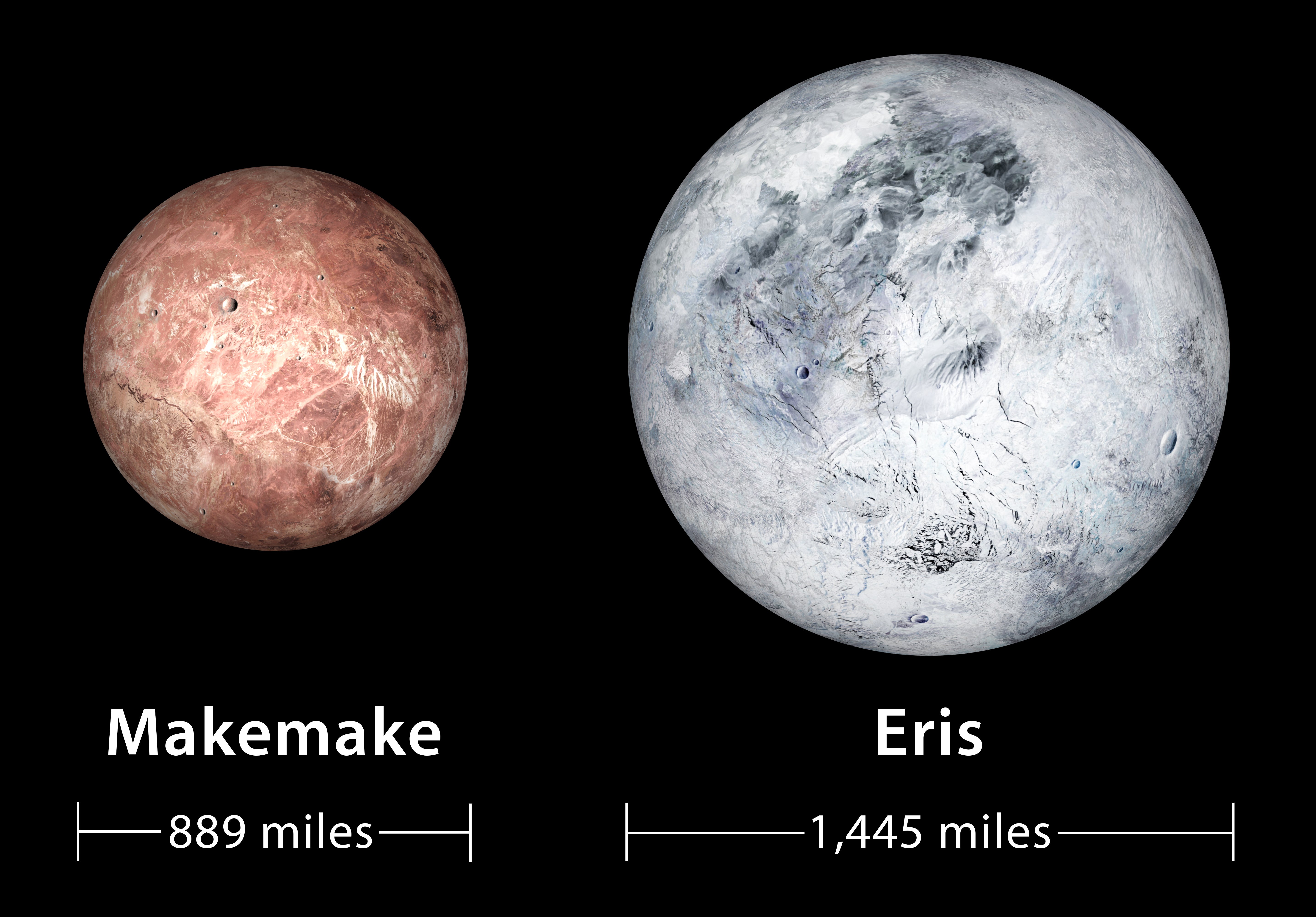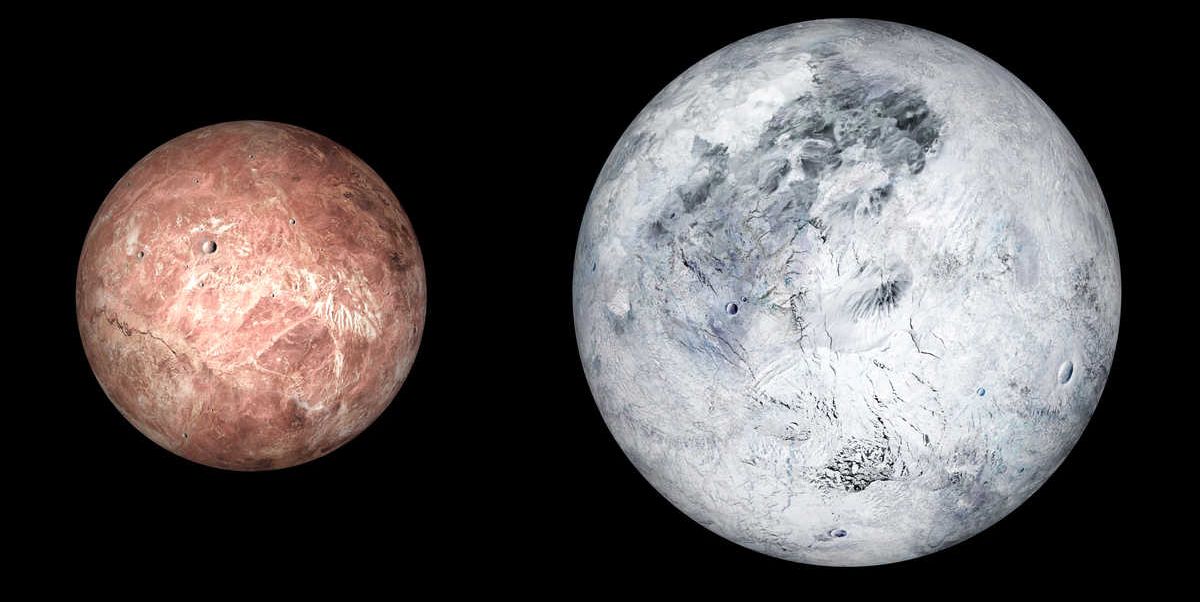
The outer reaches of the Solar System, known as the Kuiper belt, is often seen as an icy wasteland and its dwarf planets perfectly preserve the priomordial ice of the early Solar System. However, a new study suggests that two of the farthest flung celestial bodies—the dwarf planets Makemake and Eris—could be home to liquid oceans. This evidence comes from observations made by the James Webb Space Telescope via its NIRSpec infrared instrument.
Our Sun, much like the countless other stars throughout the universe, has a life-supporting sweet-spot known as the "Goldilocks zone." This idea is pretty intuitive—if you're too far from a host star, it's too cold for life to take hold, and if you're too close, it's too hot. But as humans have continued exploring our Solar System, scientists have discovered that our cosmic neighborhood isn't quite that simple.
One big example is Europa—the sixth-largest moon of Jupiter—which is outside the Goldilocks zone, yet is kept warm due to the gas giant's tidal heating. Now, two twin papers published in the journal Icarus say that surprising sources of warmth can even be found in some of the most distant celestial bodies in our Solar System.
The team—co-lead by the Texas-based Southwest Research Institute (SwRI)—discovered evidence of hydrothermal activity in the dwarf planets Makemake and Eris, which are both located in the Kuiper Belt far beyond even the orbit of their sibling dwarf planet Pluto. This evidence, as with many astronomical discoveries nowadays, was made possible thanks to NASA's $10 billion James Webb Space Telescope (JWST).
"We see some interesting signs of hot times in cool places," SwRI's Christopher Glein, the lead author of one of the studies, said in a press statement. "I came into this project thinking that large Kuiper Belt objects (KBOs) should have ancient surfaces populated by materials inherited from the primordial solar nebula, as their cold surfaces can preserve volatiles like methane. Instead…we found evidence pointing to thermal processes producing methane from within Eris and Makemake."

(Examples of what could be going on beneath the methane ice crust of Makemake and Eris.)
While Eris is roughly the same size as Pluto and Makemake is about the same size as Pluto's moon, Charon, both dwarf planets are far beyond even Pluto's icy corner of the Solar System. Everyone's favorite demoted planet travels a lonely orbit around the Sun at about 39 astronomical units (or AU, a unit that describes the average distance between the Earth and the Sun), but Makemake is at 45.8, and AU and Eris is a mind-boggling 68 AU away. That's so far that the Sun would only look like a particularly bright star, rather than the fiery orb that fills Earth's skies.
SwRI scientists examined isotope ratios in Makemake's and Eris' crusts, which are composed largely of methane ice. Using JWST's NIRSpec infrared instrument to make spectroscopic observations, the team discovered that the ratio of deuterium—a kind of heavy hydrogen—to plain ole hydrogen (or the D/H ratio), as well as carbon ratios, confirmed that these dwarf planet's icy crusts were younger than previously believed.
"The D/H ratio is like a window. We can use it in a sense to peer into the subsurface," Glein said in a press statement. "Our data suggest elevated temperatures in the rocky cores of these worlds so that methane can be cooked up. Molecular nitrogen (N2) could be produced as well, and we see it on Eris. Hot cores could also point to potential sources of liquid water beneath their icy surfaces."
That's right—even in the farthest reaches of the Kuiper belt, worlds can apparently still contain liquid water. This also means that these far-flung dwarf planets could contain hot cores still churning and bubbling with geologic dynamism.
But to know for sure, NASA, ESA, or some other space agency would need to cook up another deep space mission to have a closer look—and that could take some time. New Horizons, which launched back in 2006, is only 59 AU away from Earth, which is still some 8.3 billion miles away from Eris (even after an 18-year-long journey).
"After the New Horizons flyby of the Pluto system, and with this discovery, the Kuiper Belt is turning out to be much more alive in terms of hosting dynamic worlds than we would have imagined," Glein said in a press statement. "It's not too early to start thinking about sending a spacecraft to fly by another one of these bodies to place the JWST data into a geologic context."

2 Dwarf Planets Are Hiding Something Incredible Beyond Pluto’s Lonely Orbit
James Webb’s latest gaze into the cosmos reveals unexpected secrets within the Kuiper Belt's icy realms.
Research:
Abstract:
Dwarf planets Eris and Makemake have surfaces bearing methane ice of unknown origin. This ice can provide important insights into the origin and evolution of volatiles in the outer solar system. Deuterium/hydrogen (D/H) ratios were recently determined from James Webb Space Telescope (JWST) observations of Eris and Makemake (Grundy et al., 2024b), giving us new clues to decipher the origin of methane. Here, we develop geochemical models to test if the origin of methane could be primordial, derived from CO2 or CO ("abiotic"), or sourced by organics ("thermogenic"). We find that primordial methane (as currently understood) is inconsistent with the observational data, whereas both abiotic and thermogenic methane can have D/H ratios that overlap the observed ranges. This suggests that Eris and Makemake either never acquired much methane during their formation, or their original inventories were removed and then replaced by internally produced methane. Because producing abiotic or thermogenic methane likely requires temperatures above ∼150 °C, we infer that Eris and Makemake have rocky cores that underwent substantial radiogenic heating. Their cores may still be warm/hot enough to make methane. This heating could have driven hydrothermal circulation at the bottom of an ice-covered ocean to generate abiotic methane, and/or metamorphic reactions involving accreted organic matter could have occurred in response to heating in the deeper interior, generating thermogenic methane. Additional analyses of relevant thermal evolution model results and theoretical predictions of the D/H ratio of methane in the solar nebula support our findings of elevated subsurface temperatures and an apparent lack of primordial methane on Eris and Makemake. It remains an open question whether their D/H ratios may have evolved subsequent to methane outgassing. We also suggest that lower-than-expected D/H and 84Kr/CH4 ratios in Titan's atmosphere disfavor a primordial origin of methane there as well. Recommendations are given for future activities to further test proposed scenarios of abiotic and thermogenic methane production on Eris and Makemake, and to explore these worlds up close so that we can see if they bear additional evidence of endogenic processes.


